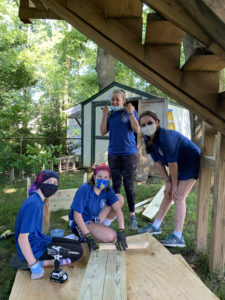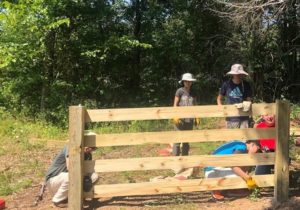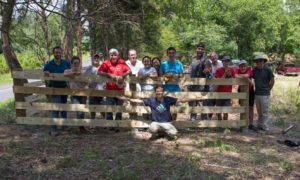I have been volunteering with Operation Hood for the past few years. Operation Hood helps feral cats; I was initially drawn to them because of my love for cats. So when looking for ideas for my Eagle Scout Project, I decided to help Operation Hood by making cat houses.
I originally had the idea in March, but due to COVID-19, I couldn’t begin until mid-July. During that time, I decided to reuse some old cat houses my grandfather had in storage rather than start from scratch. We also converted old dog boxes that needed to be cleaned, sanitized, and painted. After about three days of hard work transferring the cat houses to my house and then to Operation Hood, I finally could start the project. The hardest part of the project was working around the weather. Everything was planned out, but unfortunately, it began to rain a lot, like every weekend. We had to work around it. Eventually, we had to bring out canopies so we could start working on putting the fronts on the houses, staining the houses, and building the cat tree. Then we had to postpone painting the wooden ramps until the following weekend due to the rain.
This project was harder than I thought it would be. I had to figure out how to relay the ideas that I had on paper and in my head to my Scout volunteers. The project helped me with my leadership, planning, and communication skills. I also learned to plan for anything, especially the weather. During this project, some of our wood was cut wrong as well, so we had to adjust our plans slightly.
I found my favorite aspect of the project was giving back to an organization that I truly believe in. They are doing such great work and care so much for the cats. It was a wonderful feeling seeing (within 5 minutes of completing the project) cats utilizing what we just built. It made the project worth it.

 When I learned that Bailey’s Elementary School in Vienna, VA, needed some garden boxes, I was inspired to help. I’ve always liked the school as my mother works there, and I particularly enjoy the idea of garden boxes that would help kids learn more about nature. So I decided to reach out to the school and present my plan for my Eagle Scout Service Project.
When I learned that Bailey’s Elementary School in Vienna, VA, needed some garden boxes, I was inspired to help. I’ve always liked the school as my mother works there, and I particularly enjoy the idea of garden boxes that would help kids learn more about nature. So I decided to reach out to the school and present my plan for my Eagle Scout Service Project. The task seemed daunting at first. Breaking the earth for my Eagle Scout project was no easy feat. I wanted to construct the front fence of the start of a new equestrian park for a local non-profit horse equine-assisted therapy organization. Driving out to the property, parking on the side of the road, I tried to peer in to see what I was working with. I shook my head in disbelief; from the road, I could not walk even ten feet into the property. It was overgrown, trees lining the front of the property, and bugs swarming my every step. How was I supposed to build a fence where I couldn’t even see the ground? However, I chose to help the organization; helping the therapy center made me feel meaning in my work, and the knowledge that less fortunate children could benefit from it only convinced me more to take this project on.
The task seemed daunting at first. Breaking the earth for my Eagle Scout project was no easy feat. I wanted to construct the front fence of the start of a new equestrian park for a local non-profit horse equine-assisted therapy organization. Driving out to the property, parking on the side of the road, I tried to peer in to see what I was working with. I shook my head in disbelief; from the road, I could not walk even ten feet into the property. It was overgrown, trees lining the front of the property, and bugs swarming my every step. How was I supposed to build a fence where I couldn’t even see the ground? However, I chose to help the organization; helping the therapy center made me feel meaning in my work, and the knowledge that less fortunate children could benefit from it only convinced me more to take this project on. On the day of the project, after all the preparation, laying out the construction flags, measuring the fence distance, and renting equipment, I thought a fence cannot be that difficult to construct right? I was wrong. Off the bat, I faced even more obstacles. Drilling holes in the ground proved to be a pain in the ass, brittle, rocky earth testing my paper plan. After all the work I put in, I was not going to be stopped by a faulty power auger. My perfect plan was put to a halt in its tracks. As I pondered the possibility of working well into the night, it dawned on me that I should implement Plan B, one that just sprung into my mind. Keeping the workers focused and not idle became a new priority as the other parts of my old plan finished. I diverted my resources to help drill holes. Through the beating sun, we finally managed to finish the project after seven hours of hard labor, in front of me was a completed 300-foot fence. I would have never thought I would transform the wilderness into an orderly, pretty fence, a trailblazer for the equestrian park.
On the day of the project, after all the preparation, laying out the construction flags, measuring the fence distance, and renting equipment, I thought a fence cannot be that difficult to construct right? I was wrong. Off the bat, I faced even more obstacles. Drilling holes in the ground proved to be a pain in the ass, brittle, rocky earth testing my paper plan. After all the work I put in, I was not going to be stopped by a faulty power auger. My perfect plan was put to a halt in its tracks. As I pondered the possibility of working well into the night, it dawned on me that I should implement Plan B, one that just sprung into my mind. Keeping the workers focused and not idle became a new priority as the other parts of my old plan finished. I diverted my resources to help drill holes. Through the beating sun, we finally managed to finish the project after seven hours of hard labor, in front of me was a completed 300-foot fence. I would have never thought I would transform the wilderness into an orderly, pretty fence, a trailblazer for the equestrian park.